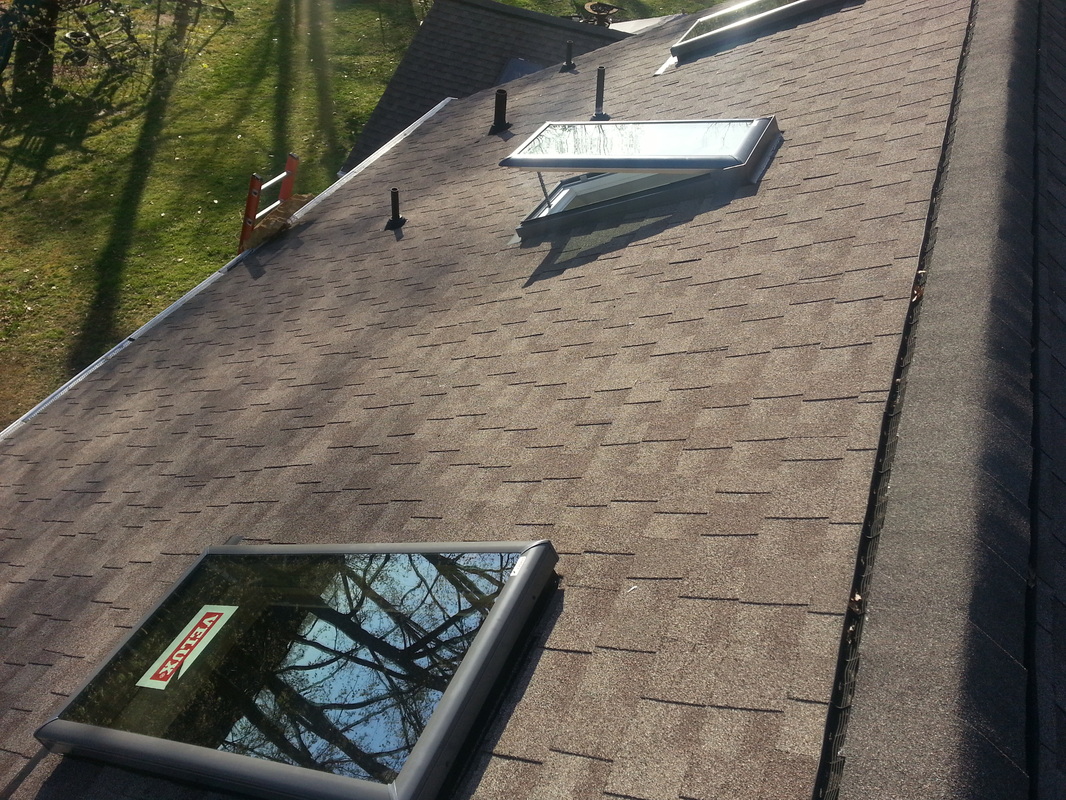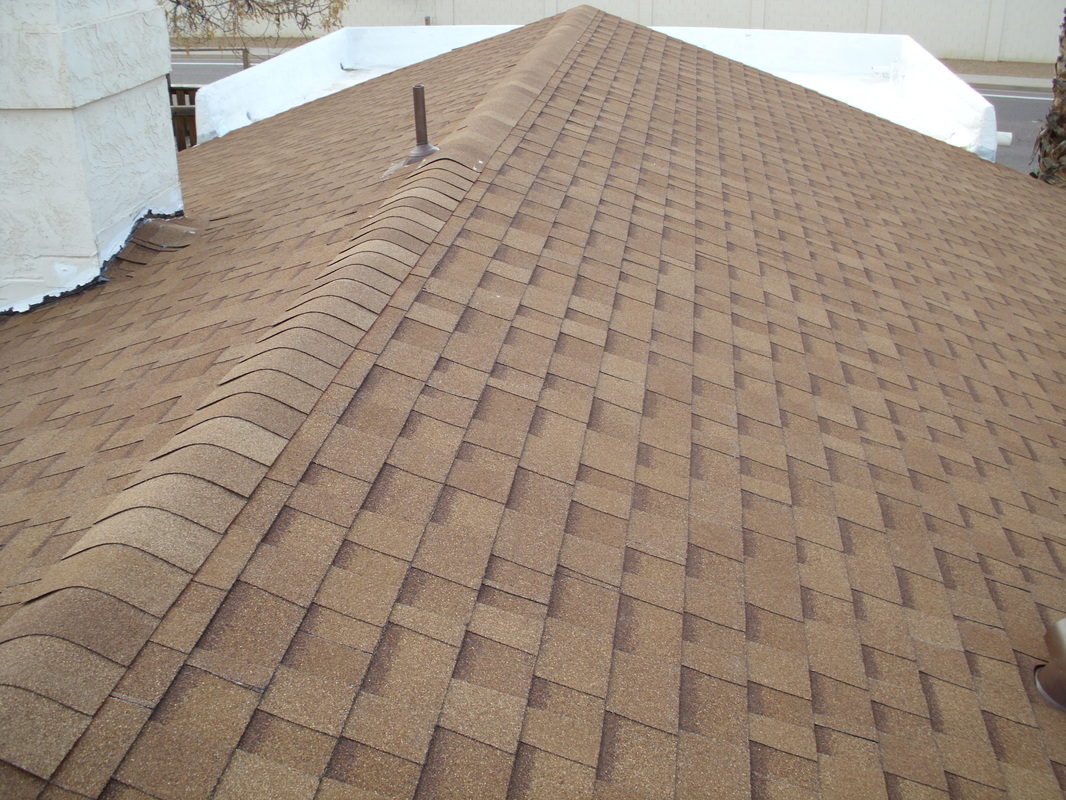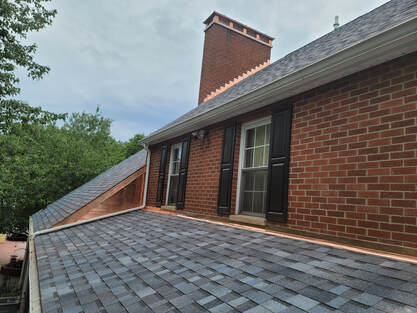
Roofing shingles were created by Henry Reynolds in 1903. He cut asphalt saturated rolls that were surfaced with stone and cut them into individual 8 in. x 16 in. pieces. By 1939 approx. 11 million shingles were being produced. The word "shingle" came from the German word "Schindel" which means a roofing slate. Shingles are installed by laying them in courses, then layed offset from each other. All shingle roofs are installed from the bottom, the gutter end, and eventually up to the ridge of the roof. A felt underlayment is installed to the roof decking to prevent leaks from wind driven rain and ice dams.
Shingles are made with petroleum hydrocarbons and over time the oils soften in the sun and gradually wash away in the rain. After extensive granule loss the fibers in the shingle shrink and eventually it will expose the nail and will start leaking. Asphalt shingles come in a wide range of colors and brands. Lighter colored shingles are highly preferred because it reflects the heat better than a darker shade of shingle. Almost all brands of shingles have copper or other chemical substances to prevent the growth and spreading of algae.
There are 2 main types of shingles: 3 tab and dimensional. Dimensional shingles, also called architectural shingles, are the most popular design of shingles. dimensional shingles are thicker, stronger and is a lot more durable. They do cost a little more than a 3 tab shingle but they have a longer lifespan. 3 tab shingles are the 2nd most popular type of shingle and they have a flat look.
Asphalt shingles are made by many different manufacturers. The most popular shingle we install is made by Owens Corning. It is a dimensional shingle that has a "Sure Nail Strip". The sure nail strip is a fiber strip on the shingle where you install the nails. It has up to 9 times better nail blow through resistance and has a 2.5 times stronger nail pull through resistance. The Owens Corning sure nail comes in a wide range of colors and comes with a wind rating/warranty of up to 130 MPH wind resistance.
Shingles are made with petroleum hydrocarbons and over time the oils soften in the sun and gradually wash away in the rain. After extensive granule loss the fibers in the shingle shrink and eventually it will expose the nail and will start leaking. Asphalt shingles come in a wide range of colors and brands. Lighter colored shingles are highly preferred because it reflects the heat better than a darker shade of shingle. Almost all brands of shingles have copper or other chemical substances to prevent the growth and spreading of algae.
There are 2 main types of shingles: 3 tab and dimensional. Dimensional shingles, also called architectural shingles, are the most popular design of shingles. dimensional shingles are thicker, stronger and is a lot more durable. They do cost a little more than a 3 tab shingle but they have a longer lifespan. 3 tab shingles are the 2nd most popular type of shingle and they have a flat look.
Asphalt shingles are made by many different manufacturers. The most popular shingle we install is made by Owens Corning. It is a dimensional shingle that has a "Sure Nail Strip". The sure nail strip is a fiber strip on the shingle where you install the nails. It has up to 9 times better nail blow through resistance and has a 2.5 times stronger nail pull through resistance. The Owens Corning sure nail comes in a wide range of colors and comes with a wind rating/warranty of up to 130 MPH wind resistance.
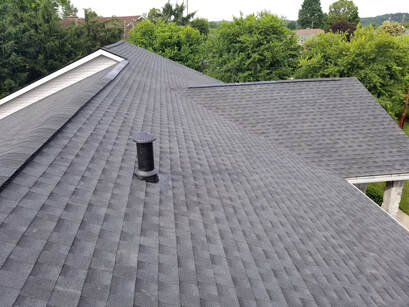
Four out of five residential roofs are made of asphalt shingles or continuous sheets of asphalt called roll roofing, which is usually reserved for low-slope roofs not visible from the ground. The only difference between regular asphalt shingles or fiberglass is a bottom mat of fiberglass mesh that is lighter, stronger and longer-lasting than asphalt. Fiberglass-mat shingles are a good choice for reroofing jobs, as they reduce the load carried by the rafters without giving up durability.
Shingle weight is an important factor on both new roofs and on reroofing jobs because heavier shingles last longer, carry a longer warranty and generally offer a better fire rating. Of course, they are more expensive and lighter shingles. The heavyweights are a great choice for new homes and additions, but a questionable choice for reroofing jobs, where the weight can overload the roof structure.
You don’t often see a bright green, blue, or red roof- even though asphalt shingles are available with granules in those colors- because they can become a bit oppressive after a few seasons. Off-white or light gray shingles make a house look larger, but will mar more easily than dark shingles and show wear sooner (even though they will not wear out any faster than dark shingles). Light colors on the roof can reflect more sunlight than dark, which will keep the house cooler in summer and reduce air conditioning costs. If gaining heat is more important, a dark shingle would be the most energy-efficient choice.
Most asphalt shingles should last without leaking for 15 to 20 years. Some last longer even 25 to 30 years. After about 15 years, however, you might start checking for signs of wear. But don’t jump the gun. There is no advantage in reroofing a building ahead of time – Before the shingles have started to deteriorate and years before they are ready to spring a leak.
Reroofing consists of applying new shingles over the existing roofing material. This is less expensive and easier than a tear-off job, which requires that the old roofing be stripped off and hauled away.
The first step in determining whether or not to reroof is to check the rake or edge of the roof to find out how many roofing layers there are. Drip edge is sometimes applied before reroofing and may hide evidence of previous layers.
Here are the four progressive stages of shingle wear to look for. First, you may notice the tiny chips embedded in the surface of asphalt shingles, called granules, accumulating in gutters and at downspout outlets. Second, you will see bare black patches of tar appearing as more granules are lost. It is very hard to see on a dark roof. In the third stage, exposed sections of the shingles, called tabs, have lost most of their surface granules and start to become brittle. In the fourth stage, brittle shingle tabs crack and break. Bare, black patches that appear as the tabs break off are unmistakable. At this point, you are likely to have small leaks that may start to rot the wooden roof deck and rafters even if you do not see large water stains on the ceiling.
Shingle weight is an important factor on both new roofs and on reroofing jobs because heavier shingles last longer, carry a longer warranty and generally offer a better fire rating. Of course, they are more expensive and lighter shingles. The heavyweights are a great choice for new homes and additions, but a questionable choice for reroofing jobs, where the weight can overload the roof structure.
You don’t often see a bright green, blue, or red roof- even though asphalt shingles are available with granules in those colors- because they can become a bit oppressive after a few seasons. Off-white or light gray shingles make a house look larger, but will mar more easily than dark shingles and show wear sooner (even though they will not wear out any faster than dark shingles). Light colors on the roof can reflect more sunlight than dark, which will keep the house cooler in summer and reduce air conditioning costs. If gaining heat is more important, a dark shingle would be the most energy-efficient choice.
Most asphalt shingles should last without leaking for 15 to 20 years. Some last longer even 25 to 30 years. After about 15 years, however, you might start checking for signs of wear. But don’t jump the gun. There is no advantage in reroofing a building ahead of time – Before the shingles have started to deteriorate and years before they are ready to spring a leak.
Reroofing consists of applying new shingles over the existing roofing material. This is less expensive and easier than a tear-off job, which requires that the old roofing be stripped off and hauled away.
The first step in determining whether or not to reroof is to check the rake or edge of the roof to find out how many roofing layers there are. Drip edge is sometimes applied before reroofing and may hide evidence of previous layers.
Here are the four progressive stages of shingle wear to look for. First, you may notice the tiny chips embedded in the surface of asphalt shingles, called granules, accumulating in gutters and at downspout outlets. Second, you will see bare black patches of tar appearing as more granules are lost. It is very hard to see on a dark roof. In the third stage, exposed sections of the shingles, called tabs, have lost most of their surface granules and start to become brittle. In the fourth stage, brittle shingle tabs crack and break. Bare, black patches that appear as the tabs break off are unmistakable. At this point, you are likely to have small leaks that may start to rot the wooden roof deck and rafters even if you do not see large water stains on the ceiling.
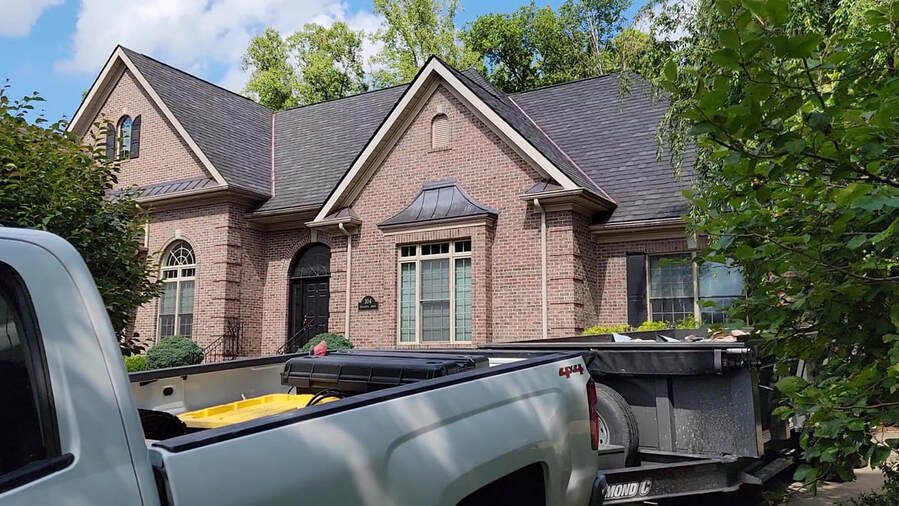
This is a GAF Camelot 2 shingle we did for a client. It is an upgraded shingle that has a slate-like appearance. It comes with a manufacturer limited warranty against algae discoloration for 25 years. It is made with time-release algae-fighting technology.
This client also upgraded the valleys and put copper in all the valleys on this home. This was a larger project with approximately 80 squares of shingles. We also custom made and installed all new copper flashing. As you can see in the picture, we also did copper on the bay window and installed custom copper on the eyebrow and a few bump outs on the front of the home.
This client also upgraded the valleys and put copper in all the valleys on this home. This was a larger project with approximately 80 squares of shingles. We also custom made and installed all new copper flashing. As you can see in the picture, we also did copper on the bay window and installed custom copper on the eyebrow and a few bump outs on the front of the home.
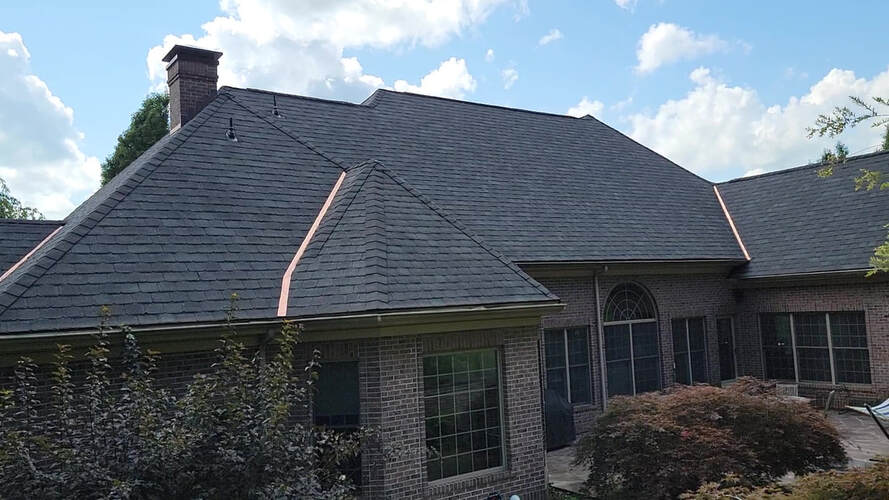
Adding these extra custom copper details to this home gives it a very distinguished look and will last a very very long time. The client chose a Royal slate color shingle, which goes elegantly with the exterior of the house. There are many other colors to choose that GAF Camelot 2 has to offer as well. We also install other upgraded shingles also, there are many to choose from. A roof, if installed correctly, will last a lifetime so why not upgrade and have a beautiful roof that you can take pride in and have the assurance and peace of mind that you will not have to deal with costly leaks and damages to the interior of your home. This client is very satisfied with his roof!
